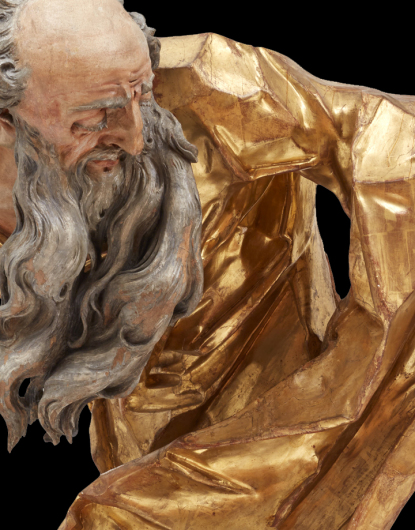Expression: Lviv Rococo Sculpture
Masterpiece sculptures from Lviv: Johann Georg Pinsel at Wawel Royal Castle
March 31 – October 22, 2023
Sharp folds of drapery breaking into a jumble of geometric forms. Majestic figures captured in free, yet dramatic movement. Bodies in arranged in graceful S-curves seemingly dance. Faces with sharp features. Abraham, Samson, the Virgin Mary, Saint John, angels, Jesus Christ. Arrayed before us is a sculptural theater of poignant biblical scenes by Johann Georg Pinsel. The polychrome and gilded works of art, which come from the church in Hodovytsya near Lviv, have been exhibited in the Louvre in Paris, the Winter Palace in Vienna, and in the National Museum – Palace of the Dukes of Lithuania in Vilnius. From March 30, these splendid masterpieces, which are absolutely unique in 18th-century European art, can be admired at Wawel Royal Castle in the exhibition Expression: Lviv Rococo Sculpture.
The exhibition has been organized under the honorary patronage of the Minister of Culture and National Heritage, Professor Piotr Glinski.Sharp folds of drapery breaking into a jumble of geometric forms. Majestic figures captured in free, yet dramatic movement. Bodies in arranged in graceful S-curves seemingly dance. Faces with sharp features. Abraham, Samson, the Virgin Mary, Saint John, angels, Jesus Christ. Arrayed before us is a sculptural theater of poignant biblical scenes by Johann Georg Pinsel. The polychrome and gilded works of art, which come from the church in Hodovytsya near Lviv, have been exhibited in the Louvre in Paris, the Winter Palace in Vienna, and in the National Museum – Palace of the Dukes of Lithuania in Vilnius. From March 30, these splendid masterpieces, which are absolutely unique in 18th-century European art, can be admired at Wawel Royal Castle in the exhibition Expression: Lviv Rococo Sculpture.
Curators: Joanna Pałka, Agata Dworzak
FROM THE HODOVYTSYA ALTAR TO WAWEL ROYAL CASTLE
The Wawel exhibition presents almost all of the surviving Hodovytsya sculptures, including Pinsel’s seminal figural group Samson Slaying the Lion, which is being shown in Poland for the first time. Other works include an exquisite ornamental console, which originally served as a base for a statue of the Mother of Sorrows.
Among the works on loan from Lviv is the Crucifix by Maciej Polejowski, which was once the focus of the theatrical arrangement of the high altar. It is accompanied by statues of the Mother of Sorrows and Saint John. Another sculptural group on view is the magnificent Abraham’s Sacrifice. In addition to the sculptures from the high altar, a virtuoso bas-relief depicting Jesus Teaching in the Temple from the pulpit decoration along with complementary Personifications of the Old and New Testament. Inset into the wall of the pulpit, which was suspended high above the ground, the bas-relief was not intended to be viewed close-up.
The Lviv sculptures are complemented by two works from Polish collections: Christ Crucified, attributed to Maciej Polejowski – the only one of his works in the Wawel collection, and a never-before exhibited sculpture of the so-called Lviv Rococo school. The latter work is a processional crucifix from church, which was brought to Wroclaw in the spring of 1946 by Fr. Jaroslaw Chomicki, the last pastor of All Saints’ Parish in Hodovytsya.
Among the works on loan from Lviv is the Crucifix by Maciej Polejowski, which was once the focus of the theatrical arrangement of the high altar. It is accompanied by statues of the Mother of Sorrows and Saint John. Another sculptural group on view is the magnificent Abraham’s Sacrifice. In addition to the sculptures from the high altar, a virtuoso bas-relief depicting Jesus Teaching in the Temple from the pulpit decoration along with complementary Personifications of the Old and New Testament. Inset into the wall of the pulpit, which was suspended high above the ground, the bas-relief was not intended to be viewed close-up.
The Lviv sculptures are complemented by two works from Polish collections: Christ Crucified, attributed to Maciej Polejowski – the only one of his works in the Wawel collection, and a never-before exhibited sculpture of the so-called Lviv Rococo school. The latter work is a processional crucifix from church, which was brought to Wroclaw in the spring of 1946 by Fr. Jaroslaw Chomicki, the last pastor of All Saints’ Parish in Hodovytsya.
VEIT STOSS’S ARTISTIC GREAT-GRANDSON, OR PINSEL (UN)DISCOVERED
Johann Georg Pinsel remains a mysterious figure in art history. Few of his works survive; many were destroyed during the Soviet era. Archival accounts on the artist are, unfortunately, very scarce, and it was not until 1993 that his name and approximate date of death were established. The sculptor probably came from Germany, Austria, Bohemia, or Moravia. From 1750 to 1761 he was active in the southeastern region of the Polish-Lithuanian Commonwealth, where he left behind works in wood and stone. He opened a workshop in Buchach (Pol. Buczacz) around 1750, and for ten years collaborated with the prominent architect Bernard Meretyn. Pinsel’s surviving works come from Lviv, Monastyryska (Pol. Monasterzyska), Buchach, and Hodovytsya, among others. The last mention of the artist dates to 1761. Pinsel scholar Professor Jan Ostrowski called him the greatest sculptor in Polish art between Veit Stoss (Pol. Wit Stwosz) and Xawery Dunikowski. He also dubbed him Stoss’s artistic great-grandson due to features in his work that exhibit an affinity with the High Gothic: a combination of a particular naturalism and expression.
Joanna Pałka, exhibition co-curator
The honorary patronage of the Minister of Culture and National Heritage, Professor Piotr Glinski.

 Honorowy patronat Ministra Kultury i Dziedzictwa Narodowego
Honorowy patronat Ministra Kultury i Dziedzictwa Narodowego


















